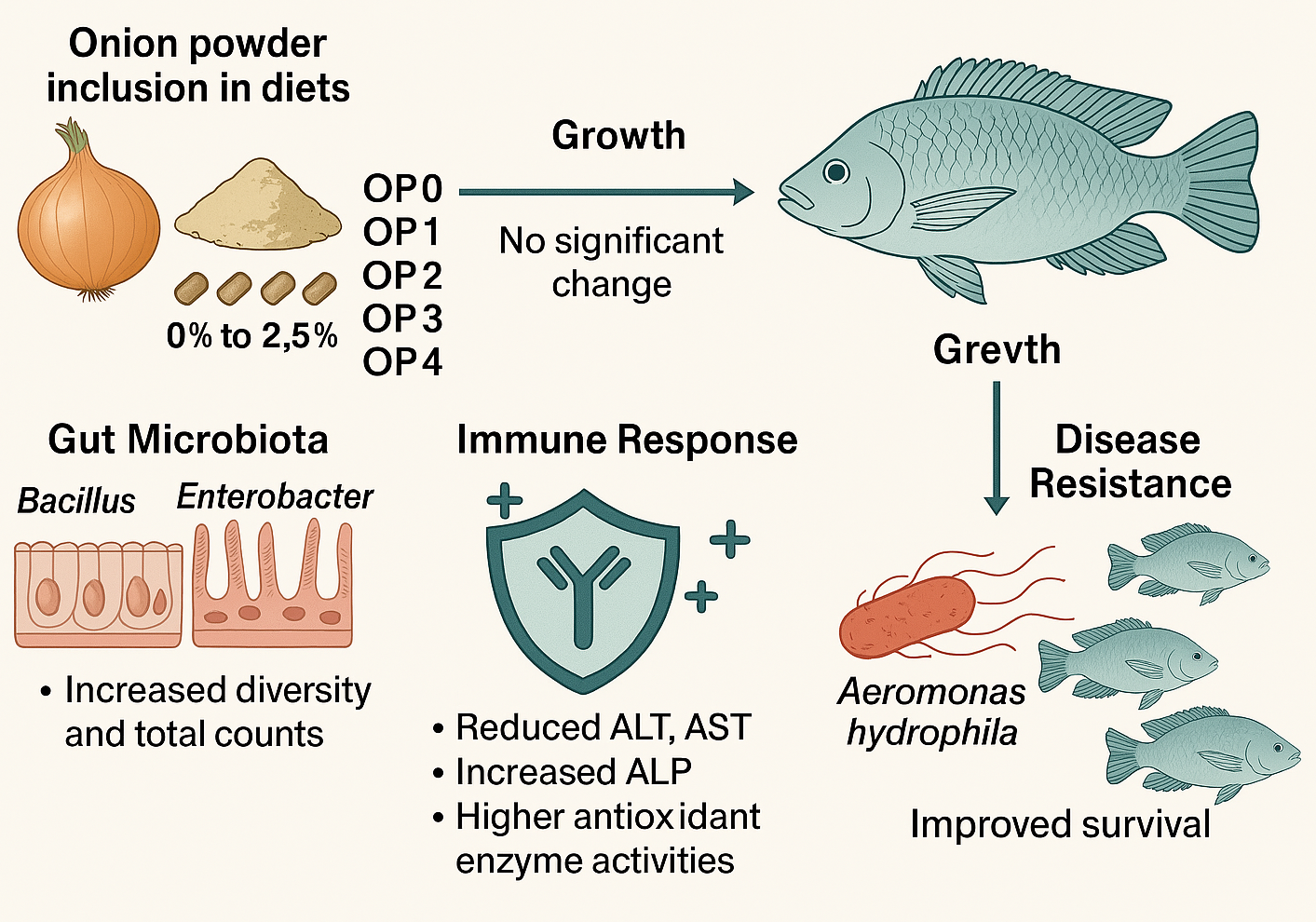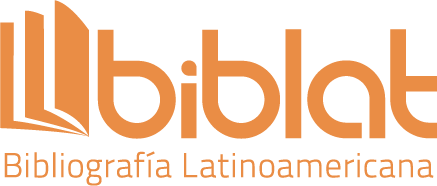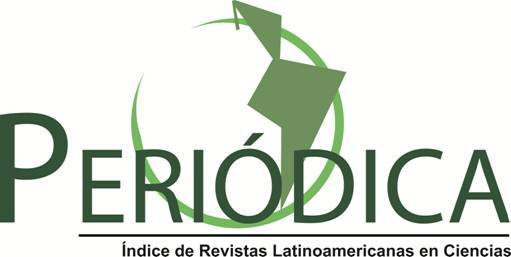Crecimiento, dimensión intestinal, respuesta inmune y resistencia a Aeromonas hydrophila en tilapia del Nilo (Oreochromis niloticus) alimentada con cebolla (Allium cepa. L).
Efectos de la cebolla en el crecimiento y la inmunidad de la tilapia
DOI:
https://doi.org/10.18633/biotecnia.v27.2622Palabras clave:
polvo de cebolla, Oreochromis niloticus, Aeromonas hydrophila, intestino de pescado, sangre de pescadoResumen
Este estudio evaluó el polvo de cebolla (Allium cepa) en dietas de Oreochromis niloticus, centrándose en el crecimiento, el área intestinal, la respuesta inmune y la resistencia a Aeromonas hydrophila. Se formularon seis dietas, OP0, OP1, OP2, OP3, OP4 y OP5 con inclusión de polvo de cebolla de 0% a 2.5%, y se alimentaron a grupos triplicados de peces (1.79 ± 0.14 g) durante 10 semanas. Luego, los peces fueron desafiados con A. hydrophila y monitoreados durante 14 días. Si bien el crecimiento no se alteró significativamente con la suplementación con cebolla durante 10 semanas, la supervivencia después del desafío con Aeromonas hydrophila mejoró significativamente. La diversidad bacteriana y los recuentos totales aumentaron en los peces alimentados con cebolla intestinal, siendo Bacillus y Enterobacter las especies dominantes. La bioquímica sérica indicó niveles reducidos de alanina aminotransferasa y aspartato aminotransferasa en los peces alimentados con dietas de cebolla de 0.5% a 1.5%, mientras que la fosfatasa alcalina aumentó. La actividad de las enzimas antioxidantes fue generalmente mayor en los grupos suplementados con cebolla, con niveles reducidos de malondaldehído. La altura y el ancho de las vellosidades no mostraron diferencias significativas entre los tratamientos. El desafío con Aeromonas hydrophila en tilapia del Nilo mostró un porcentaje de supervivencia relativa (SPR) significativamente mayor en los grupos suplementados con cebolla, con un récord del 100 % en los grupos alimentados con una concentración del 1,0 % o superior. Este estudio reveló que la inclusión de cebolla del 1 % al 1,5 % en las dietas de tilapia del Nilo resultó en una mejor respuesta inmunitaria, salud intestinal y resistencia a enfermedades.
Descargas
Citas
Abdel‐Tawwab, M. & Abbass, F. E. (2017). Turmeric powder, Curcuma longa L., in common carp, Cyprinus carpio L., diets: Growth performance, innate immunity, and challenge against pathogenic Aeromonas hydrophila infection. Journal of the World Aquaculture Society, 48, 30– 312. https ://doi.org/10.1111/jwas.12349
Abdel‐Tawwab, M., Adeshina, I., Jenyo‐Oni, A., Ajani, E. K., & Emikpe, B. O. (2018). Growth, physiological, antioxidants, and immune response of African Catfish, Clarias gariepinus (B.), to dietary clove basil, Ocimum gratissimum, leaf extract and its susceptibility to Listeria monocytogenes infection. Fish and Shellfish Immunology, 78, 346–354. https ://doi.org/10.1016/j.fsi.2018.04.057
Adeyemo, O. K. (2005). Haematological and histopathological effects of cassava mill effluent in Clarias gariepinus. African Journal of Biomedical Research 8: 179-183.
Agbebi, O.T., Ogunmuyiwa, T.G. and Herbert, S.M. (2013). Effect of dietary garlic source on feed utilization, growth and Histopathology of the African catfish (Clarias gariepinus). J. Agric. Sci. 5 (5), 26–34. http://dx.doi.org/10.5539/jas.v5n5p26.
Ajani, E. K., Orisasona, O., Kareem, O. K., Osho, F.E, Adeyemo, A. O, Omitoyin, B. O and Adekanmbi, A. O. (2020). Growth performance, gut ecology, immunocompetence and resistance of Oreochromis niloticus juveniles fed dietary Curcumin longa. Croatian Journal of Fisheries, 78, 145-156. DOI: 10.2478/cjf-2020-0014
Amar E. C., Faisan, J. P. Jr. (2011). Efficacy of an inactivated ‘‘vaccine’’ and nutritional additives against white spot syndrome virus (WSSV) in shrimp, Penaeus monodon. Israeli J Aquacult-Bamidgeh 63:IIC:2011.529–538
Apines-Amar, M. J. S., Amar, E. C., Faisan, J. P., Rolando, V., Pakingking, R. V., Satoh, S. (2012). Dietary onion and ginger enhance growth, hemato-immunological responses, and disease resistance in brown-arbled grouper, Epinephelus fuscoguttatus. AACL BIOFLUX 5 (4), 231–239.
Aly, S.M. and Mohamed, M.F. (2010). Echinacea purpurea and Allium sativum as immunostimulants in fish culture using Nile tilapia (Oreochromis niloticus). J. Anim. Physiol. Anim. Nutr. 94 (5), 31–39. http://dx.doi.org/10.1111/j.1439-0396.2009.00971.x.
AOAC. (2005). Official methods of analysis of the association of analytical chemists international (18th edn). Rockville, MD: Official Methods.
Azevedo, R. V., Filho, J. C. F., Pereira, S. L., Cardoso, L. D., Andrade, D. R and Vidal Junior, M. V (2016). Dietary mannan oligosaccharide and Bacillus subtilis in diets for Nile tilapia (Oreochromis niloticus) Acta Scientiarum. Animal Sciences Maringá, 38(4):347-353. Doi: 10.4025/actascianimsci.v38i4.31360
Baba, T., J. Imamura, K. Izawa and Ikeda K (1988). Immune protection in carp, Cyprinus carpio L., after immunization with Aeromonas hydrophila crude lipopolysaccharide. Journal of Fish Diseases, 11: 237-244.
Bello O. S., Olaifa F. E., Emikpe B. O. and Ogunbanwo S. T. (2013). Potentials of walnut (Tetracarpidium conophorum Mull. Arg) leaf and onion (Allium cepa Linn) bulb extracts as antimicrobial agents for fish. Afri. J. Micro. Rese. 7: 2027–2033.
Buetler, E., Duron, O. and Kelly, B. M. (1963). Improved method for the determination of blood glutathione. Journal of Laboratory and Clinical Medicine, 61, 882–890.
Cardella M. A. and M. E. Eimers (1990). Safety and potency testing of federal licensed fish bacterins. J Aquat Anim Health, 2: 49–55.
Farahi, A., Kasiri, M., Sudagar, M., Iraei, M., Shahkolaei, M.D. (2010). Effect of garlic (Allium sativum) on growth factors, some hematological parameters and body compositions in rainbow trout (Oncorhynchus mykiss). AACL Bioflux 3 (4), 317–323.
Givens, C. E, Ransom, B, Bano, N et al. (2015). Comparison of the gutmicrobiomes of 12 bony fish and 3 shark species. Mar Ecol Prog Ser 2015;518:209–23.
Gornal, A. G., Bardawill, J. C., David, M. M. (1949). Determination of serum proteins by means of biuret reaction. J. Biol. Chem. 177: 751-766.
Habig, W. H., Pabst, M. J., and W.B. Jakoby (1974). Glutathione S-transferases. The first enzymatic step in mercapturic acid formation. J. Biol. Chem., 249: 7130-7139
Hopwood D. (1996). Fixation and Fixatives. In S. A. Bancroft J., Theory and practice of histological techniques. (pp. 201-4). New York: Churchhill Livingstone
Hrubec, T. C., Cardinalle, J. L., and Smith, S. A. (2000). Hematology and plasma chemistry reference intervals for cultured Tilapia (Oreochromis hybrid). Veterinary Clinical Pathology, 29(1), 7–12. https://doi.org/10.1111/j.1939-165X.2000.tb003 89.x
Jollow, D. J., Michell, J. R., Zampaglionic, N. and Gillete, J. R., (1974). Bromobenzene‐induced Liver necrosis: Protective role of glutathione and evidence for 34‐bromobenzene oxide as hepatotoxic metabolite. Pharmacology, 11, 151–169. https ://doi.org/10.1159/00013 6485
Kalyankar, A.D., Gupta, R.K., Bansal, N., Sabhlok, V.P., Singh, D. (2013). Effect of garlic (Allium Sativum) against Aeromonas hydrophila and health management of Swordtail, Xiphophorus helleri A.D. J. Environ. Sci. Sustainability JESS 1 (2), 41–48
Kaplow, L. S. (1955). A histochemical procedure for localizing and valuating leukocyte alkaline phosphatase activity in smears of blood and marrow. Blood, 10, 1023.
Kocour, M., Lynhard, O., Gela, D., and Rodina, M. (2005). Growth performance of all–female and mixed–sex common carp, Cyprinus carpio L. population in central European climatic conditions. Journal of the World Aquaculture Society, 36, 103–113.
Mello, H. D., Moraes, J. R. E., Niza, I. G., Moraes, F. R. D., Ozório, R. O. A., Shimada, M. T., … Claudiano, G. S. (2013). Efeitos benefices de probióticos no intestino de juvenis de Tilapia‐do‐Nilo. Pesquisa Veterinária Brasileira, 33, 724–730. https ://doi.org/10.1590/S0100-736X2 01300 0600006
Narvaez, E., Berendsen, J., Guzman, F., Gallardo, J. A and Mercardo, T (2010). An immunological method of quantifying bacterial activity in Salma salar (Linnaeus 1758) skin mucus. Fish and Shellfish Immunology 28:235-239
Nwanna, L. C., Ajani, E. K., & Bamidele, S. F. (2013). Use of lactic acid bacteria from Nile tilapia Oreochromis niloticus as probiotics for sustainable production and improvement in welfare of the Fish. The Israeli Journal of Aquaculture ‐ Bamidgeh, IJA_66.2014.977, 12. http://hdl.handle.net/10524/ 49134 .
Oladele, O. A., Emikpe, B. O. and Bakare, H. (2012). Effects of dietary garlic (Allium sativum linn.) supplementation on body weight and gut morphometry of commercial broilers. International Journal of Morphology 30. 1: 238-240.
Olutiola,P.O., Famurewa, O. and Sonntag, H.G. (2000). An Introduction to microbiology, a practical Approach. Tertiary Text Book series
Omitoyin, B. O., Ajani, E. K., Adesina, B. T., and Okuagu, C. N. F. (2006). Toxicity of lindane (gamma hexachloro‐cyclottexane) to Clarias gariepinus (Buchel, 1822). World Journal of Zoology, 1, 57–63.
Omitoyin B. O., Ajani, E. K, Orisasona O, Bassey, H. E, Kareem, K. O, Osho, F. E. (2019). Effect of guava Psidium guajava (L.) aqueous extract diet on growth performance, intestinal morphology, immune response and survival of Oreochromis niloticus challenged with Aeromonas hydrophila. Aquac Res. 2019;50:1851–1861. https ://doi.org/10.1111/are.14068
Oresegun, A and Alegbeleye, W.O. 2001. Serum and tissue thiocynate concentration in tilapia (Oreochromis niloticus) fed cassava peels based diets supplemented with D,L methionine. Proceedings of the 21st Fisheries Society of Nigeria on Fish Nutrition and Fish Feed. Eyo, A.A. Eds. Ilorin. 107 - 115.
Ostrowska, E., Gabler, N. K., Sterling, S. J., Tatham, B. G., Jones, R. B., Eagling, D. R., Jois, M., Dunshea, F. R. (2004). Consumption of brown onions (Allium cepa var. cavalier and var. destiny) moderately modulates blood lipids, haematological and haemostatic variables in healthy pigs. Br. J. Nutr. 91, 211–218.
Osuigwe, D.I., A.I. Obiekezie and G.C. Onuoha, 2005. Some haematological changes in hybrid catfish (Heterobranchus longifilis x Clarias gariepinus) fed different dietary levels of raw and boiled jackbean (Canavalia ensiformis) seed meal. Afr. J. Biotechnol., 4: 1017-1021.
Reitman, S., & Frankel, S. (1957). A colorimetric method for the determination of serum glutamic oxalacetic and glutamic pyruvic transaminases. American Journal of Clinical Pathology, 28, 56–63. https ://doi.org/10.1093/ajcp/28.1.56
Saleh, N., Michael, M and Toutou, M (2015). Evaluation of garlic and onion powder as phyto-additives in the diet of sea bass (Dicentrarcus labrax).Egy. J. Aqua. Res., 41 (1): 211–217.
Schmidt, V. T, Smith, K. F, Melvin, D. W and Amaral-Zettler, L. A (2016). Community assembly of a euryhaline fish microbiome during salinity acclimation. Mol Ecol. 24:2537–50. doi: 10.1111/mec.13177
Soosean, C., Marimuthu, K., Sudhakaran, S., and Xavier, R. (2010). Effect of mangosteen (Garcinia mangostana L.) extracts as a feed additive on growth and haematological parameters of African catfish (Clarias gariepinus) fingerlings. European Review for Medical and Pharmacological Sciences, 14, 605–611
Taher, M. M., Mojer, A. M., Muhammed, S. J., Al-Dubakel, A. Y., Salih, O. A and Sabti, Z. A (2024). Effect of onion meal and commercial prebiotic on growth and survival of common carp, Cyprinus carpio juveniles cultivated in earthen ponds. Iraqi Journal of Aquaculture, 21(2): 29-44
Thepot, V., Campbell, A. H., Rimmer, M. A., and Paul, N. A. (2021). Meta analysis of the use of seaweeds and their extracts as immunostimulants for fish: A systematic review. Reviews in Aquaculture, 13(2), 907–933. https://doi.org/10.1111/raq.12504
Tietz, N. W., Burtis, C. A., Duncan, P., Ervin, K., Petitclerc, C. J., Rinker, A. D., … Zygowicz, E. R. (1983). A reference method for measurement of alkaline phosphatase activity in human serum. Clinical Chemistry, 29, 751–761.
Upadhaya, S. D., and Kim, I. H. (2017). Efficacy of phytogenic feed additive on performance, production and health status of monogastric ani‐ mals – A review. Annals of Animal Science, 17(4), 929–948. https://doi. org/10.1515/aoas.2016-0079
Vashney, R., and Kale, R. K. (1990). Effects of calmodulin antagonists on radiation‐induced lipid peroxidation in microsomes. International Journal of Radiation Biology, 58, 733–743. https ://doi.org/10.1080/0955300901 4552121
Vigneshpriya, D and N, krishnaveni (2016). Effect of garlic and onion incorporated feed on the growth and nutritional status on the fresh water fish Tilapia, Oreochromis mossambicus (Peters, 1852). International Journal of Fisheries and Aquatic Studies 2016; 4(5): 253-257
Wolf, S. P. (1994). Methods Enzymol., 1994, 223, 182–189.
Wong, S., Waldrop, T., Summerfelt, S. et al. (2013). Aquacultured rainbow trout (Oncorhynchus mykiss) possess a large core intestinal microbiota that is resistant to variation in diet and rearing density. Appl Environ Microbiol. 79:4974–84.
Xu, L., Ran, C., He, S., Zhang, J., Hu, J., Yang, Y., Zhou, Z. (2015). Effects of dietary yeast nucleotides on growth, non‐specific immunity, intestine growth and intestinal microbiota of juvenile hybrid tilapia Oreochromis niloticus ♀ Oreochromis aureus ♂. Animal Nutrition, 1, 244–251. https ://doi.org/10.1016/j.aninu.2015.08.006
Yagi, K. (1984). Increased lipid peroxides initiates atherogenesis. BioEssays, 1:58–60. https ://doi.org/10.1002/bies.95001 0205

Descargas
Publicado
Cómo citar
Número
Sección
Licencia
Derechos de autor 2025

Esta obra está bajo una licencia internacional Creative Commons Atribución-NoComercial-CompartirIgual 4.0.
La revista Biotecnia se encuentra bajo la licencia Atribución-NoComercial-CompartirIgual 4.0 Internacional (CC BY-NC-SA 4.0)









_(2).jpg)






